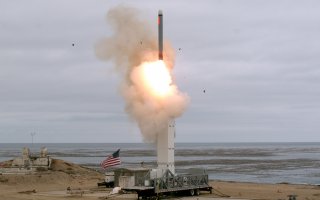 This past year, the United States has witnessed a greatly increased threat from North Korea. U.S. intelligence has now confirmed that North Korea not only possesses up to sixty nuclear warheads, but it has developed the miniaturization technology required to mount them atop a number of different types of intercontinental ballistic missiles (ICBMs), which it has tested over the past year.
This past year, the United States has witnessed a greatly increased threat from North Korea. U.S. intelligence has now confirmed that North Korea not only possesses up to sixty nuclear warheads, but it has developed the miniaturization technology required to mount them atop a number of different types of intercontinental ballistic missiles (ICBMs), which it has tested over the past year.
Dr. Peter Pry, who served as chief of staff to the Commission to Assess the Threat to the United States from Electromagnetic Pulse (EMP) Attack, which Congress unwisely chose to disband late last year, currently serves as Executive Director of the EMP Task Force on National and Homeland Security. He told Congress that there is the possibility that Pyongyang has deployed two “super EMP” satellites in low-earth orbit over the continental United States which, if detonated over the country without warning, could kill up to 290 million Americans within a year. Pry also estimates that Russia currently possesses at least three times more nuclear weapons than the United States. In addition, communist China recently admitted having built three thousand miles worth of underground tunnels where it may be concealing hundreds of mobile ICBMs with 1,600–1,800 nuclear warheads, according to Col. Gen. Viktor Yesin, a former commander of Russia’s Strategic Rocket Forces. That number is considerably more than the number that the United States currently has deployed.
Meanwhile, Russia has tried to build underground towns and command centers from which its political and military leadership could fight—and possibly win—a nuclear war with the United States. Russia has also deployed a massive national-defense system, which the late former Defense Intelligence Agency and Central Intelligence Agency analyst William T. Lee documented in his excellent book “The ABM Charade—A Study in Elite Illusion and Delusion.” That defense system may be capable of shooting down most U.S. warheads launched in response to a hypothetical Russian nuclear first strike.
America has never been more threatened by existential threats than it is today. Yet there are many liberal claims President Trump is imagining threats from Russia and Communist China despite his laudable “America First” National Security Strategy. On the other side of the political spectrum, many Republicans mistakenly believe that the greatest threat Americans face today is from Islamic terrorists whose numbers have greatly multiplied due to ill-considered U.S. military interventions in the Middle East, which has left the U.S. military with a readiness deficiency unseen since the Carter administration.
Thankfully, Utah Republican Rep. Chris Stewart, who previously co-sponsored the SHIELD Act, is leading the way with his planned introduction of legislation that, if passed, would serve to protect America’s electrical power grid from catastrophic EMP attack and potentially save the lives of tens of millions of U.S. citizens in the unfortunate event such an attack actually materialized. A similar bill known as the GRID Act was approved by the House of Representatives in June 2010 with unanimous bipartisan support but which, regrettably, was never considered by the U.S. Senate. Defending the homeland against such existential threats would necessitate building a comprehensive national missile-defense system. Deterring such threats would also entail rebuilding our strategic nuclear arsenal, which was allowed to decay under President Trump’s two immediate predecessors, but which he has signaled a desire to modernize.
The best way to strengthen and expand America’s nuclear deterrent in the near term would be to increase the operations tempo of the Ohio-class nuclear ballistic missile submarine fleet from four of fourteen being at sea at any given time to ten. This would ensure that over two-thirds of our nuclear missile submarine fleet could not be destroyed in their ports in a hypothetical pre-emptive nuclear first strike by America’s enemies, providing the United States with a much more credible second strike retaliatory capability 2.5 times larger. Another important step President Trump could take would be to renounce dangerously unverifiable New START Treaty limitations. This is necessary in view of multiple reports of Russian treaty violations and to allow America to upload both it’s ICBM’s and SLBM’s with additional strategic nuclear warheads to their maximum payload capacity.
Doing so would not necessarily entail any significant increases in the U.S. defense budget. President Trump ran on extricating America’s brave servicemen and servicewomen from unnecessary foreign wars and has proposed withdrawing our troops from Syria, which could help fund such measures. In addition, Congress could vote to cut overly expensive conventional weapons programs and reduce our military bases and force structure somewhat to pay for strategic programs which will, alone, safeguard America’s survival.
America stands as an example to the world and continues to serve as the great bastion of freedom and hope to hundreds of millions of innocent people who live under communist and Islamist tyranny and oppression, but America can only retain this status if Congress acts now to defend against the existential threat of nuclear and EMP attack.
David T. Pyne has a M.A. in National Security Studies from Georgetown University and currently serves as the Utah Director for the EMP Task Force for National and Homeland Security, an official Congressional Advisory Board, and as a member of the Secure the Grid Coalition. He previously served as National Security Policy Director for United States Sen. Mike Lee (R-UT), as a vice president of the Association of the U.S. Army’s Utah chapter, as an International Programs Manager on the Department of the Army Headquarters Staff and as a consultant to the Missile Defense Agency.
This article first appeared in 2018 and is reprinted due to reader interest.
No comments:
Post a Comment